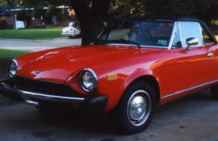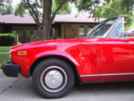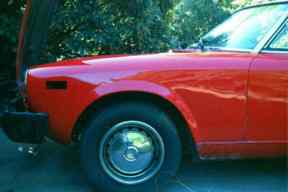
FAQ
Project.
By
Ron Conlon
Email: rconlon@ou.edu
 FAQ Project. |
Dent fix 101 By Ron Conlon Email: rconlon@ou.edu |
 The before fender |
|||
 |
|

|
|
Choose the best paint to get the best finish since the cost of cheap paint is only $10-20 less per quart. Dupont single stage was my choice to match the car. Getting the right color took two tries, for me, and staring at hundreds of paint chips until I saw them in my sleep. The ones with holes in the middle were best to slide the gas filler cover under to match. Go into the sun to recheck the match in that light. Electronic scanners help but the dealer probably won't guarantee anything, if they help at all, since they are not applying the paint. I am told that paint shops blend the new color over the old for as much as 2 feet to hide differences in color matches. Now it is time to paint. Wipe the fender with mineral spirits to clean, say a prayer and have someone experienced with the paint gun shoot your car. Long even strokes of the sprayer with the paint, reducer and hardener properly mixed to a blood consistency. Do one light coat and then a wet coat. Let dry and do another and another. This art takes experience that you can learn by making errors or just get help. Clear coat is a different technique but both should be color sanded with 2000 grit to remove the bugs and dust specks after 1-2 weeks to set the paint. That is why the extra coats are necessary. Points to remember are: use fresh filler, paint and materials; get the best materials; use as little filler as possible; any mistakes can be redone or covered; mask the car with care to prevent over spray and it is body work work work. Finally if you do too good a job the rest of the car will seem dowdy and you will be doing the whole car next. |
|---|
 The final paint yet to be color sanded |
The paper is wrapped several times about the stick and is flipped often, cleaned in the water and torn off to get a fresh surface. An experienced hand is good so practice on your parts car to get an even surface and get a feel for the job. You don't want to cut through the new paint. Your fender will look all dull again. Time to buff it. The buffing is also done in 3 stages using polishing compounds of decreasing coarseness. An electric variable speed rotary buffer is used. Slower speeds will prevent cutting through the paint. The coarse compound is applied using a sheepskin pad and the finer with a sponge type pad. Done right this should give a show finish. If you skip straight to 2000 paper and buffing you get that factory finish that won't make the rest of the car look dowdy. I did my final buff by hand with 3M polishing compound and a soft cloth. The color initially seems lighter than original but this seems to be getting darker with age and waxing. |